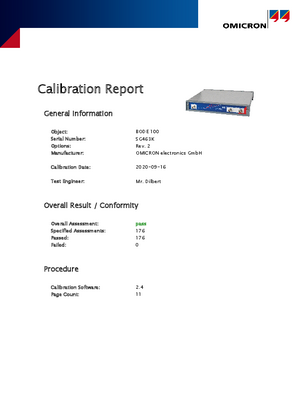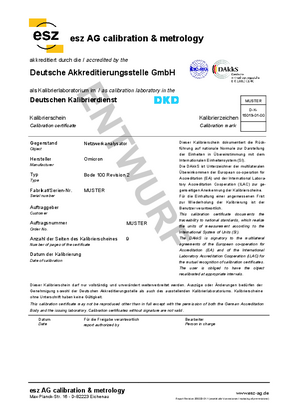Bode 100 - Calibration & Repair
Repair Service
OMICRON Lab offers component-level repair for the Bode 100 and it's accessories. A Bode 100 repair includes a new factory calibration as well as a warranty extension by 6 months.
If your device needs repair, please contact us.
If you are unsure and want to check the Bode 100 yourself, please have a look at the step-by-step guide on how to check if your Bode 100 is still functional and within the specifications.
Calibration Service for Bode 100 Device
Note: Due to the high stability of our equipment, we do not demand you to send in the unit for re-calibration on a regular basis. Furthermore, you can perform software calibration to compensate for some errors. Please check out the details at the end of this page.
Factory Calibration (ISO 9001):
At OMICRON we offer a factory calibration for the Bode 100. The factory calibration is also performed as part of the manufacturing process. Factory calibration includes adjustment and calibration of the device and can be repeated anytime. The calibration includes a 6-month warranty renewal. Please ask for ISO 9001 Calibration and Inspection (Order number: P0005784).
Calibration Certificate & Calibration Report:
Every unit comes with a calibration certificate free of charge. The certificate is included in the delivery of a new device and after a repeated calibration. A detailed calibration report is available on request. Below you can find a sample certificate and a sample report for a Bode 100 R2 device.
ISO/IEC 17025 Calibration:
In collaboration with the esz AG we offer an ISO/IEC 17025 calibration for the Bode 100. Please contact us and ask for ISO/IEC 17025 Calibration and Adjustment (Order number: P0005789). The ISO/IEC 17025 calibration includes a factory calibration and adjustment at OMICRON as well as the additional ISO/IEC 17025 calibration report (see sample below).
Note that the ISO/IEC 17025 calibration includes impedance calibration values for the one-port impedance measurement. The following reference measurements are included:
- 8 mH inductance measurement at 1 kHz & 10 kHz
- 10 nF capacitance measurement at 1 kHz & 100 kHz
- 1 µF capacitance measurement at 1 kHz & 10 kHz
Recommended Calibration Period:
By performing software calibration/correction the user can ensure accurate Gain/Phase and Impedance measurements. For more details on software correction, please check out the next section and refer to the Bode User Manual. A parameter that changes with time and cannot be compensated by User-Range or Full-Range calibration is the frequency of the internal reference oscillator. If your quality assurance guidelines require a periodic calibration we recommend a re-calibration every two to five years.
The oscillator in the Bode 100 exhibits the following drift performance:
| Bode 100 Rev. 1 | Bode 100 Rev. 2 | |
|---|---|---|
| < 1 year after adjustment | ± 15 ppm ≙ ± 15 Hz @ 1 MHz | ± 2 ppm ≙ ± 2 Hz @ 1 MHz |
| < 3 years after adjustment | ± 25 ppm ≙ ± 25 Hz @ 1 MHz | ± 4 ppm ≙ ± 4 Hz @ 1 MHz |
For more details, please check out the technical data section.
Software Calibration/Correction
Bode 100 and Bode Analyzer Suite offer you the following possibilities to increase the accuracy of your measurements.
User-Range Calibration / Full-Range Calibration:
External calibration/compensation, done by the user to remove the influence of the measurement setup such as cables or probes. This calibration/correction can be done at each measurement. For more information please refer to the user manual.
Internal Device Calibration:
At the first start-up on a computer, the Bode Analyzer Suite performs a self-calibration of the Bode 100, measuring and compensating internal attenuators and amplifiers. This calibration can be repeated anytime in the Bode Analyzer Suite or Bode Automation Interface. We recommend repeating the internal device calibration whenever the environmental conditions change significantly.



